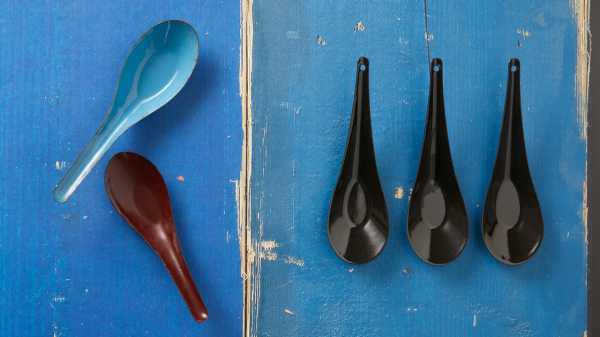
The introduction to the most recent version of Emily Post’s Table Setting Guides includes the following mandate: “Only set the table with utensils you will use. No soup; no soup spoon.” Sounds pretty reasonable, as far as Emily Post rules go, but I beg to differ. Who says that soup spoons are only for soup, or should even be called soup spoons at all? I have long admired the way utensils are used in parts of Southeast Asia, including Thailand: the spoon is the most important instrument, held in the dominant hand and used to bring food—soupy or otherwise—to the mouth; the fork plays a supporting role, used only to push morsels onto the spoon, and chopsticks are generally reserved for noodles. I’ve been eating Thai food this way ever since I learned about the custom, dipping spoonfuls of rice into coconut curries, herding green-papaya salad, spangled with peanuts, chili, and tiny dried shrimp, into the curvature of a spoon. It feels elegant, efficient, economical—nary a drop or a morsel is wasted.
Only recently did it occur to me that I could apply the same principle to all kinds of other foods I’d normally eat with a fork or chopsticks. Working from home one day, I used a spoon to eat leftover rice I’d fried with peas and eggs and doused in chili oil. I’ve never taken to the Italian practice of using a spoon to aid in twirling long pasta around a fork, but short pasta—fusilli coated heavily in Marcella Hazan’s tomato sauce and grated parmesan, for example—seems made to be eaten with a spoon. Leftover slow-roasted salmon, tender enough to fall apart at the slightest touch? Pan-fried cubes of tofu with florets of steamed broccoli? Creamy curds of butter-scrambled egg, doused in hot sauce? Spoonworthy, all. Even salads can be good candidates, so long as the ingredients are bite-size, as evidenced by the chef Michel Nischan’s popular recipe for “Use a Spoon” Chopped Salad. The current vogue for “grain bowls” is nothing if not spoon-friendly.
Why, then, does spoon-forward eating in Western culture feel so thrillingly outré? In her book “Consider the Fork: A History of How We Cook and Eat,” the writer and historian Bee Wilson explains how spoons came to be relegated to liquids and soft foods. The fork was not used widely as an eating utensil until the seventeenth century, when an Elizabethan traveller in Italy noticed “a custom ‘that is not used in any other country,’ namely, a ‘little fork’ for holding meat as it was cut.” By the eighteenth century, forks, used with knives, had become rampant throughout Europe. Before that, people had eaten with their hands, but also, Wilson notes, with spoons: “The triumph of the knife and fork went along with the gradual transition to using china dinner plates, which were generally flatter and shallower than older dishes and trenchers. When bowls were used for all meals, the ideal implement was a spoon.” (Perhaps it’s no coincidence that my newfound spoon appreciation has been accompanied by a preference for serving most foods in bowls, preferably wide, shallow ones that allow you to spread out an array of different foods as on a plate, but provide a three-hundred-and-sixty-degree bumper wall, for when you want to scoop up the last bite of something—with your spoon, of course.) Over time, Wilson writes, the fork became a symbol of politeness, “because it was less overtly violent than a knife, less babyish and messy than a spoon. Forks were advised for everything from fish to mashed potatoes, from green beans to cream cake. Special forks were devised for ice cream and salads, for sardines and terrapins. The basic rule of Western table manners in the nineteenth and twentieth centuries was: if in doubt, use a fork.”
It’s true that spoons are used for feeding babies; they are the first utensil most humans encounter, and often the last. They are also used to gently nurse the ailing back to health. Spoons are instruments of peace—unlike forks, with their imperative to stab, menacing prongs bared like teeth, or sharp knives, sheathed in wooden blocks, or hung, like suspects in a lineup, from magnetic strips. The most damage you could do with a spoon is to give someone a rap on the skull or the knuckles (an exception being, perhaps, the brilliantly designed grapefruit spoon, with its gently jagged tip), and it’s no coincidence that one of the most intimate and comfortable ways to physically interact with another person is called “spooning.” Marginalized on the table, spoons are, in the kitchen, absolutely essential: for scooping, for measuring, for stirring and tasting. One of my favorite kitchen accessories is a spoon rest, for gently retrieving and returning a wooden specimen dozens of times while tending to a pot of simmering beans or sauce. It’s utilitarian but also aesthetic: spoons are objects of beauty, worthy of display. Last fall, the French designer Daniel Rozensztroch published a remarkable monograph (and released a corresponding wallpaper) showing off his collection of more than two thousand spoons, gathered on his travels around the world. They’re organized by material—wood, glass, mother-of-pearl, bone, metal, horn, ceramic, enamel, porcelain—but are also dizzyingly varied in size, shape, and intended purpose.
I see no need to return to the elaborate spoon culture of the Victorian era, during which, Bee Wilson notes, “there were aspic spoons and tomato spoons, sauce spoons and olive spoons, fluted gravy ladles, bon-bon spades, tea scoops, citrus spoons, and Stilton scoops”—though I have always loved a set of family-heirloom spoons, currently in the possession of my mother, which are made specifically for iced tea (their long, straight metal handles double as straws) and lately I’ve taken to eating ice cream with a dainty demitasse spoon, meant for espresso, to make it last longer. Forks remain absolutely crucial—for linguine alla vongole, for a rare ribeye, for combing hair in a pinch. I only wish to suggest that their curvy cutlery-drawer neighbors in are, in many households, underused, and undersung.
One person who seemed to share this conviction was Thomas Ewbank, a nineteenth-century British writer who served, for several years, as the United States Commissioner of Patents. In 1844, under the pseudonym Habakkuk O. Westman, he published a delightful, hilariously thorough, semi-satirical book called “The Spoon: With Upwards of One Hundred Illustrations, Primitive, Egyptian, Roman, Medieval, and Modern,” which I recently stumbled upon. Tracing the utensil’s history through centuries, Westman elaborates on its various uses across every inch of the globe and analyzes its symbolism not only on the table and in the kitchen but as it pertains to politics, art, and religion, too. The spoon’s influence, he writes, “is felt in every department of life—in manners, morals, and even in national characteristics.” His conclusions are at turns charmingly, wildly digressive and patently (perhaps intentionally) ridiculous. “Military Tactics taught by the spoon,” he titles one chapter. He spends several pages arguing that the plot of “Don Quixote” turns on the spoon. In one bit of gonzo culinary stereotyping, he asserts, “The vivacity and other marked attributes of the French people are derived from the free use of the spoon. Steaks make a German or an Englishman portly and dull; stews, a Frenchman light and agile. On one side of the channel, fries render men heavy as dray horses; on the other, fricassees make them frisky as genets.” And yet I felt as though these lines were calling directly to me: “Every person who handles a pen is indebted to the spoon—indebted to it for his daily food; and yet who among them has ever written a line in its praise?”
Sourse: newyorker.com






